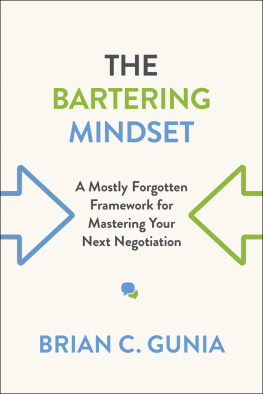Interpersonal Negotiations Breaking Down the Barriers
Interpersonal Negotiations Breaking Down the Barriers
Len Leritz

Copyright 1994 American Management Association. All rights reserved. This material may not be reproduced, stored in a retrieval system, or transmitted in whole or in part, in any form or by any means, electronic, mechanical photocopying, recording, or otherwise, without the prior written permission of the publisher
Printed in the United States of America
Contents
About This Course
As one course among many offered in our curriculum, Interpersonal Negotiations has been designed specifically for the practicing manager and the future manager. It provides private, self-paced, individualized study; learning and self-evaluation through in-text exercises; and communication between the student and AMA Educational Services staff of instructors through assignments and a final examination based on the case study as pioneered by Harvard University. Paralleling a business school course of study, AMAs curriculum makes available a stable, inclusive, and continuing transmittal of practices and perspectives to those working managers who, on their own time and at their own pace, want to continue their education.
For the past 20 years, Len Leritz has been president of a Portland, Oregon-based management consulting group, Len Leritz & Associates, Inc.
Mr. Leritz has created a proprietary developmental model that illustrates five levels of thinking and relating ability within individuals. From his model, he has created several assessment instruments, training programs, and processes to enable diverse groups to work together effectively. His first book, No-fault Negotiating, is in its second printing in the United States and England and was recently translated into Spanish. His most recent project has been the creation of Real Time Commitment, a facilitator-led, video-assisted, organizational development process.
Mr. Leritz has conducted thousands of hours of training for major corporations and universities, the health care industry, the U.S. Navy, and various government agencies. He has been a principal resource for over 100 TEC (The Executive Committee) groups across the country, and a speaker at YPO (Young Presidents Organization), American Management Association, and Inc. Conferences.
Mr. Leritz holds graduate degrees from the University of Arkansas and Seattle University. He was on the graduate faculty at Seattle University for 12 summers teaching courses in conflict management, team building, and organizational development.
The publisher wishes to thank Donald Caplin, Dennis G. McCarthy, and Jesse Nirenberg, Ph.D., for their help in reviewing the manuscript of this course.
How to Take This Course
This course consists of text material for you to read and four types of learning activities (the review questions, the first examination, the practice case, and the examination case or, in some cases, a multiple-choice final examination) for you to complete. Credit will be given only upon successful completion of the examination case or, if applicable, the final examination.
.
The various activities are designed to reinforce the concepts brought out in the text portion of the course and to enable you to evaluate your progress. The examination case will be evaluated and graded by an AMA staff instructor so that certain concepts you may otherwise have overlooked or misunderstood in your own study will be brought to your attention and clarified.
We recommend that you work at this course in a systematic way. Only by reading the text and working through the review questions at a regular and steady pace will you get the most out of this course and retain what you have learned
The Text
The most important component of this course is, obviously, the text, for it is here that the concepts and methods are first presented. Reading each chapter twice will increase the likelihood of your understanding the text fully.
In your first reading, concentrate on getting an overview of the chapters contents. Read the learning objectives at the beginning of the chapter first. They will act as guidelines to the major topics of the chapter and enumerate the skills you should master as you study the text. As you read the chapter, pay attention to the headings and subheadings. Find the general theme of each section and see how that theme relates to others. Dont let yourself get bogged down with details during the first reading; simply concentrate on remembering and understanding the major themes.
In your second reading, look for the details that underlie the themes. Read the entire chapter carefully and methodically, underlining key points, working out the details of the examples, and making marginal notations as you go.
The Review Questions
After reading a chapter, and before going on to the next, work through the review questions. Answering the questions and comparing your answers to those given will assist you in grasping the major ideas of that chapter. If you perform these self-check exercises conscientiously, you will develop a framework in which to place material presented in later chapters. This building of a mental model will help clarify the reading and, most important, will help you to apply what you have learned to your particular work situation.
The First Examination
The first examination is made up of a series of straightforward questions on what you have studied in both the text and the review questions. Answer the questions and mail the exam in one of the return envelopes to:
American Management Association
Educational Services
P.O. Box 133
Florida, NY 10921
The first examination will be graded and returned to you promptly so you may restudy areas in the course with which you had trouble.
The Practice Case
The practice case presents the activities of a fictitious company. Questions are raised that prompt you to apply the concepts you have just learned in the body of the text. The practice case, as its name implies, prepares you for the written analysis required of you in the final portion of the course, the examination case. There is no one correct answer to the practice case; it is intended to show you the thinking process involved in completing the examination case. However, there is a suggested solution to the practice case; you can compare your solution to the suggested solution.
The Examination Case
The examination case, which must be completed for course credit, presents details of a specific company with a problem or problems for you to solve. Because solutions to even the smallest problems in a real business situation often have important ramifications for the workings of the company as a whole, think through your analysis thoroughly before you compose your answers to the questions.
The first step is to read and reread the specific exam questions until you understand exactly what is being asked. Then, go back to the text and the examination case and find the place or places that give applicable information for answering those questions. When you feel you have thoroughly explored all aspects of the questions, draw your conclusions and write them as clearly and concisely as you can. Although there is no correct length, a satisfactory analysis, including recommendations, usually runs between four and six typed doubled-spaced pages.
Next page









